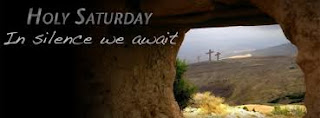Cycle B - Year II: 1 April 2018: Easter Sunday
(Liturgical Color: White)
(Liturgical Color: White)
Readings:
First Reading: Acts 10;34, 37-43
Second Reading: Colossians 3:1-4
First Reading: Acts 10;34, 37-43
Second Reading: Colossians 3:1-4
Gospel:Please Read John 20:1-9
The Lord is risen!
All Masses today in the entire universal Church start with the presiding priest joyfully greeting the congregation with this great news: The Lord is risen. Alleluia!
Indeed today is a great day of celebration as we proclaim the resurrection of our Lord Jesus Christ from the dead!
From the Vigil Mass on Holy Saturday, our joy shines forth when the very first Mass of Easter begins with the joyful singing of the Gloria and the triumphant ringing of bells.
The evangelist John brings us the Good News on Easter Sunday. The gist of the Gospel narratives:
 When Mary of Magdala came to visit the tomb of Jesus early morning on the third day, she saw the stone
When Mary of Magdala came to visit the tomb of Jesus early morning on the third day, she saw the stone
And so, the Resurrection of Jesus is the very cornerstone of our Christian faith. Because if Jesus did not rise to redeem us from sin, then everything we did during the Holy Week, and everything we do now. is going to be meaningless.
In the Catholic faith, Easter Sunday is the principal feast of the ecclesiastical year. That is why it is called the greatest feast (festum festorum). Our Lord's Resurrection is a concrete and historical event which is the strength and foundation of Christianity. It is a day of celebration, as it represents the fulfillment of our faith as Christians.
From the time of the first apostles to our generation, we too believe that our Lord Jesus Christ is indeed risen. Alleluia! Alleluia! To this day, in every Eucharistic celebration at Mass we share in Jesus' Paschal Mystery, meaning to say, in our Lord's Passion, Death and Resurrection. Because we encounter the risen Christ again in the Holy Eucharist. Thus, Easter invites us to be witnesses to the whole world that our Lord Jesus Christ is truly risen from the dead!
What then is the significance of the Easter event to all of us today? Does everything end with the resurrection story?
Well, it does not and should not. Because we do not close the story of Jesus' Resurrection. We continue to re-live this event whenever we do the acts of Jesus, meaning our Lord's acts of kindness, humility, self-sacrifice, and service to others. Because by these very Christian acts we continuously perpetuate the Resurrection of our Lord Jesus in our lives today.
In other words, whenever we do good to others we also impart Jesus and we tell them that Jesus is truly alive today, that our Lord Jesus is ready to help them and lift them from their sickness, loneliness and weariness, and restore back our dignity as God's children.
So let us pray, that the power of the Lord's Resurrection transform us into liberated and joyful people through our authentic Christian living, repentant yet full of hope and happiness.
Happy Easter to us all. And thank you for a moment with God.
Ad Jesum per Mariam!












